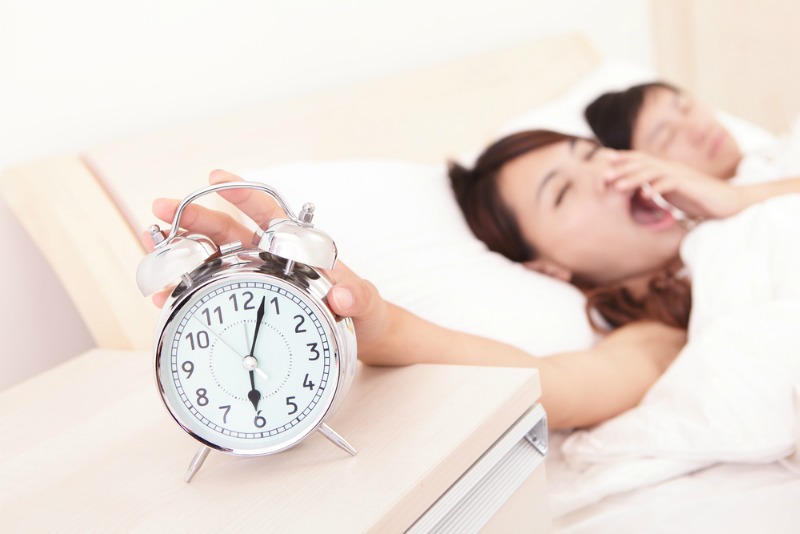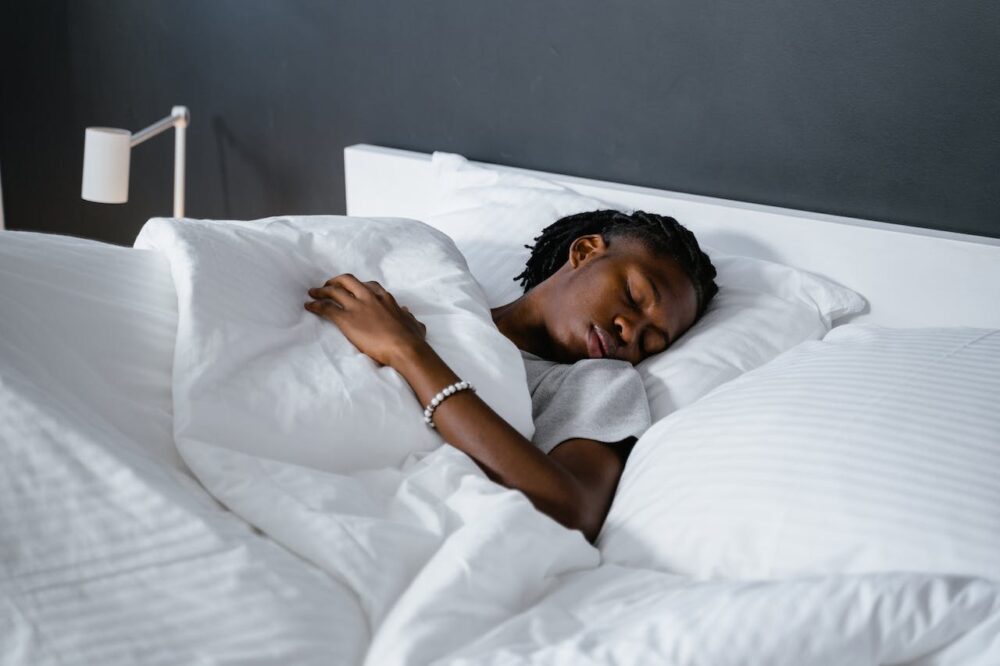What Happens When We Sleep?
10 Min Read |
Last Modified 8 April 2025 First Added 13 July 2023

Sleep can often feel like a mystery. We close our eyes, and before we know it, hours have passed, and it’s the next day. Some nights, we drift off into dreams of unknown places and memorable conversations, while other times, it feels like nothing happened at all. But the truth is, each night, our bodies follow a rhythm – cycling through the same stages of sleep, each one vital to our overall well-being.
Each sleep cycle is made up of unique and equally important stages that help us feel rested, consolidate our memories, and support the essential work our bodies do every day. In this article, we’ll explore each of these sleep stages, when they occur, and what’s really happening behind the scenes while we’re fast asleep.
During a typical 7-9 hours of sleep, your body goes through 4-6 sleep cycles. Each cycle lasts around 90 minutes and includes four distinct stages. These cycles form the natural rhythm your body follows each night, helping ensure your mind and body get the rest, repair, and restoration they need so you can wake up feeling refreshed and ready to take on a new day.
There are two main phases of sleep: Rapid Eye Movement (REM) and Non-Rapid Eye Movement (NREM). Each sleep cycle consists of four stages, each of which falls into one of these two categories—most of our time is spent in NREM. Below, we break down the different stages and what happens during each one.
The first stage is NREM sleep, the lightest and shortest phase. During this time, you’re still drifting off, which makes you particularly sensitive to disruptions that could easily pull you out of your slumber.
Still considered light sleep, stage two is when your body gradually eases into a deeper state of rest. Your heart rate slows, your body temperature drops and your muscles relax. While you’re still likely to be awoken by noises or movement, you become less aware of your surroundings as your body gets ready for stage 3.
The final stage of NREM is deep sleep, also known as slow-wave sleep. This is the most restorative phase, crucial for growth, recovery, and memory consolidation. It’s also essential for boosting your immune system. It’s much harder to wake up during this stage, and if you do, you may feel a bit groggy.
REM sleep is when most of your dreaming takes place. During this stage, your brain activity increases, and your eyes move rapidly despite the lack of visual cues. Your muscles relax and are temporarily paralysed to stop you from acting out your dreams. REM sleep plays a vital role in memory consolidation, and it’s also believed to be key for learning and processing emotions.
At the beginning of the night, our sleep cycles are made up mostly of stages 1–3, which are part of NREM sleep. As the night progresses, this shifts and we spend more time in REM sleep during the later cycles.

As we move through the different stages of each sleep cycle, changes occur not only in the brain but in the body as well. Once the brain signals that we’ve drifted off, it sends messages to the body, triggering a series of processes that help us rest, repair, and recharge throughout the night.
In the early stages of NREM sleep, your heart rate begins to slow, and your blood pressure drops, reaching its lowest point during stage N3. As your body relaxes and enters a deeper state of rest, this shift signals the transition to the parasympathetic nervous system – often called the “rest and digest” state. This process helps conserve energy, eases the strain on the cardiovascular system, and allows the body to focus on healing, memory consolidation, and other essential restorative tasks that take place while we sleep.
As we move into REM sleep in stage four, this process begins to reverse. Heart rate and blood pressure gradually rise, returning to a pace similar to when we’re awake, helping prepare the body for the transition back to consciousness.
Find out what’s considered a healthy sleeping heart rate for your age and how you can monitor it for better sleep.
As your heart rate slows, your breathing follows suit, helping your body ease into a deeper, more restful state. These changes occur as shifts in the nervous system affect the muscles that control breathing, causing both heart rate and respiration to slow in harmony. Then, as you enter REM sleep, breathing gradually returns to a more wake-like pace, sometimes becoming faster and more irregular.
As we drift off to sleep, our muscles begin to relax, just like the rest of our body. Once we reach the REM stage, they become temporarily paralysed in a process known as atonia. This helps conserve energy and, importantly, prevents us from physically acting out our dreams. When this process is disrupted, it can lead to sleep disorders such as sleepwalking, where the body is in deep sleep, but the brain remains partially active.
While we sleep, the body releases several key hormones that help regulate everything from growth and metabolism to stress and appetite. These include growth hormone, which supports tissue repair and development; cortisol, which helps prepare the body for waking; and leptin, the hormone that signals when we’re full after eating.
As you drift off to sleep, your body temperature naturally begins to drop, helping conserve energy for the vital growth and repair processes that occur overnight. When you enter REM sleep, temperature regulation becomes less efficient, and your core temperature may begin to rise slightly. Other factors, such as stress, anxiety, hormonal fluctuations, or sleep disorders, can interfere with temperature control during sleep, sometimes leading to night sweats.
The number of sleep cycles we experience each night depends on how long we sleep in one stretch, which forms our overall sleep pattern. Most people follow a monophasic sleep pattern, where all sleep occurs in one continuous block, aligning with the natural diurnal circadian rhythm – awake during the day and resting at night. However, some people follow a biphasic sleep pattern, which includes two sleep sessions, such as the traditional siesta in warmer countries or those who need an afternoon nap to function.
There are also more fragmented sleep patterns, known as polyphasic sleep, which involve multiple sleep sessions throughout the day. Popular polyphasic sleep patterns include:


While the typical sleep cycle moves through stages from N1 to REM, this isn’t always the case. Personal factors and environmental influences can affect our sleep, leading to a different balance of stages. This variation can impact how restorative our sleep is, with each stage contributing in its own way to how we feel the next day.
Each sleep cycle typically lasts around 90 minutes, allowing your brain to move through all four stages, from N1 to REM. For a truly restorative night’s rest, it’s recommended to complete 4-6 cycles, which adds up to the ideal 7-9 hours of sleep. Getting more or less sleep than this can throw off your sleep cycle balance, leaving you feeling off the next day. Sleep deprivation, in particular, can lead to a range of issues, from a weakened immune system to mental health challenges.
There are a few people who can function on less sleep. Read more in our article: Short Sleepers: Why Don’t They Need Sleep?
Your sleep chronotype is more than just being a night owl or an early bird – it’s about when you’re naturally most alert and when you’re likely to fall asleep. Morning people tend to thrive on a monophasic sleep pattern, rising with the sun and staying active throughout the day. On the other hand, night owls may find an afternoon nap beneficial, helping them power through the day and get the restful sleep they need in the early hours of the morning.

"Whether you’re a morning person or a night owl is largely determined by genetics and your body’s natural circadian rhythm. Neither is necessarily healthier and research goes both ways, but night owls may struggle more in a world designed for early risers. The most important thing is to get enough quality sleep for YOU, no matter your preference!"
As we age, the amount of REM sleep we need naturally decreases, while NREM sleep, especially deep sleep (N3), can become more fragmented. In contrast, infants and young children spend a greater proportion of their sleep in REM sleep than adults.
Sleep disorders like insomnia and sleep apnoea can disrupt the balance of our sleep cycles, leaving us with broken rest and less time in the crucial deep and REM stages.
Stress and anxiety can make it hard for the body to relax and enter the resting state needed to reach the deeper stages of sleep. As a result, you may wake up feeling tired and anxious, which can create a vicious cycle. Other mental health conditions, such as depression, have also been found to reduce the amount of time spent in REM sleep, contributing to symptoms of fatigue.
Both caffeine and alcohol can significantly impact the quantity and quality of sleep. When consumed later in the day, they can disrupt REM sleep and may cause you to wake up throughout the night, leaving you feeling less rested.
Regular exercise during the day has been found to promote deeper NREM sleep. However, physical activity too late in the day could have adverse effects, raising your heart rate and body temperature and preventing you from entering the resting state.
Foods high in sugar are infamous for keeping us awake, whereas those high in tryptophan or magnesium may help you get a better night’s rest and a more balanced cycle of REM and NREM.
Exposure to natural sunlight in the morning helps to regulate your natural circadian rhythm, keeping your sleep cycles consistent and healthy. On the other hand, blue light late in the day can interfere with natural melatonin production and reduce the amount of REM sleep we get.
Hormonal changes, such as those experienced during pregnancy, menopause, or menstruation, can disrupt sleep. Fluctuations in progesterone and estrogen can affect sleep patterns, often leading to reduced REM sleep during certain phases.
Find out more about why women may need more sleep than men.
Understanding the stages of sleep and the factors that influence them is key to improving the quality of our rest, helping us feel refreshed and energised during the day. By being mindful of how much sleep you get and the lifestyle habits that impact your rest, you can support a healthy sleep cycle and ensure your body gets the essential restorative stages it needs.